The regal Scottish terrier, Scotch terrier, or Scottie, is a compact dog with a penchant for being protective. Tracing its roots back to the 1790s, Scotties have persisted in the world as a hardy breed for protecting their owners, hunting small prey, and becoming a loving companion.
If you have a Scottish terrier — or are looking to adopt one — the guide below will help you navigate the adorable puppyhood of the Scottie dog.
Scottish Terrier Summary
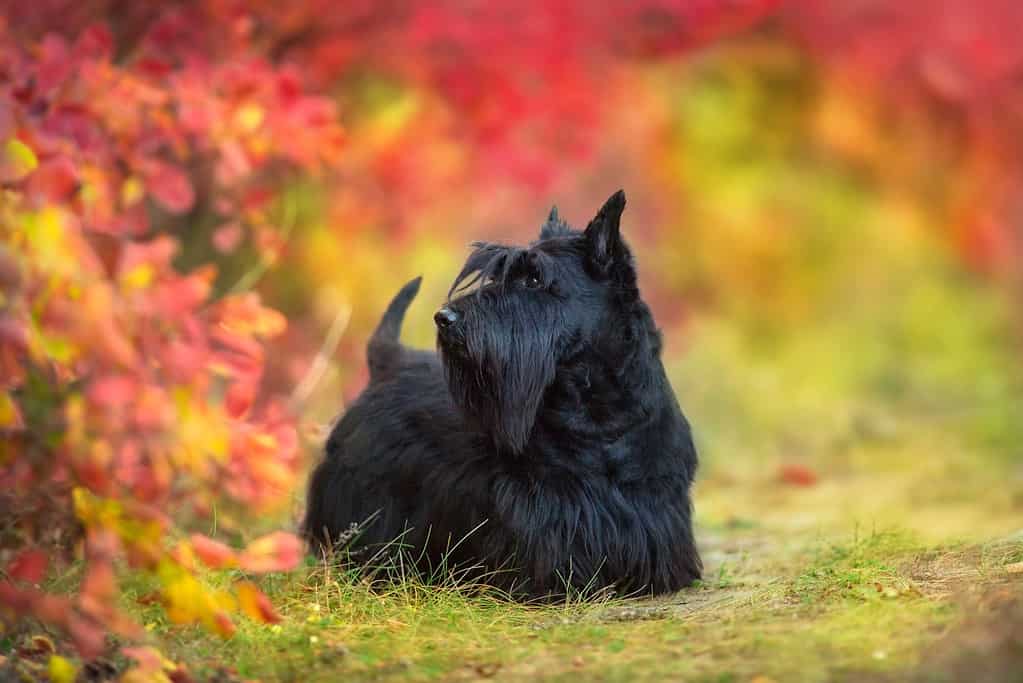
Scottish terriers became companions of hunters in the Scottish highlands.
©Nemyrivskyi Viacheslav/iStock via Getty Images
According to a representative of the Scottish Terrier Club of America, Janet Tomlinson, Scottish terriers found their purpose highly in the highlands of Scotland. In the early 1800s, these pups became tenacious hunters.
In his book General History of Quadrupeds, author Ralph Beilby remarked at length about the Scotch terrier, saying it “has a most acute smell, is generally an attendant on every pack of hounds, and is very expert in forcing foxes or other game out of their coverts. It is the determined enemy of all the vermin kind …. It is fierce, keen, and hardy; and, in its encounters with the Badger, sometimes meets with very severe treatment, which it sustains with great courage and fortitude. A well-trained veteran dog frequently proves more than a match for that hard-biting animal.”
Scottish terriers are independent, confident, and spirited. They love to hunt, play, and walk and remain aloof — or downright cantankerous — to strangers, other dogs, and smaller animals.
Scottish Terrier Growth and Weight Chart by Age
The chart below provides an estimation of a standard Scottish terrier throughout their puppyhood. However, all dogs will vary in height and weight depending on their ancestry, activity level, and lifestyle.
| Age | Male Weight | Female Weight |
|---|---|---|
| Birth | 3.5 pounds | 2.5 pounds |
| 1 Month | 4 pounds | 3 pounds |
| 6 Weeks | 4.5 pounds | 4 pounds |
| 2 Months | 5 pounds | 4.5 pounds |
| 3 Months | 6 pounds | 5 pounds |
| 4 Months | 7 pounds | 6 pounds |
| 5 Months | 9 pounds | 8 pounds |
| 6 Months | 11 pounds | 10.5 pounds |
| 7 Months | 14 pounds | 13 pounds |
| 8 Months | 16 pounds | 15 pounds |
| 9 Months | 17 pounds | 16 pounds |
| 10 Months | 18 pounds | 17 pounds |
| 11 Months | 20 pounds | 19 pounds |
| 12 Months | 21 pounds | 20 pounds |
| 2 Years | 22 pounds | 21 pounds |
When Will My Scottish Terrier Stop Growing?

Scottish terriers grow to their full size around two years old.
©Ohoho/iStock via Getty Images
As a smaller dog breed, Scottish terriers mature quicker than some larger breeds in the terrier group. The Scottie grows quickly at first and tapers off as the months wear on.
According to Dr. Mollie Newton, the founder of PetMeTwice and a seasoned veterinarian, “Scotties, like all pups, grow the fastest in their first six months.”
Dr. Newton continued, “By six to eight months, they usually reach half of their adult weight, which is typically around 18 to 22 pounds for a healthy adult. Your Scottie will be physically mature by 18 to 24 months, though they might still have some puppy-like behaviors!”
So, you can expect your Scottie to stop growing physically by two years old. They’ll probably still retain their puppy-like energy and behavior for several months more, though. After all, the breed has the nickname “diehards” for a reason!
How Big Will My Scottish Terrier Be When It’s Fully Grown?
Based on the breed standards set out by the American Kennel Club for Scottish terriers, fully-grown male Scottish terriers will weigh between 19 and 22 pounds while females will weigh slightly less — between 18 and 21 pounds. Height tends not to vary by gender. Most fully-grown Scotties stand around 10 inches high at withers (from the ground to the highest point in a dog’s shoulder blade).
Scotties remain great apartment or tiny-living dogs because owners can satisfy their exercise needs with spurts of activity. This means a quick, brisk walk or a 15-minute romp of tug-of-war a few times a day will keep your Scottie engaged, mentally stimulated, and healthy.
Keep an eye on the treats-to-exercise ratio. Scottish terriers can become obese, which negatively affects (or exacerbates disease in) other organs or body parts like joints, the heart, bones, and eyes.
When Should My Scottish Terrier Be Spayed or Neutered?
The American Kennel Club suggests owners of toy and small breed puppies consider a neutering appointment around the ages of six to nine months. This window may allow you to catch your female Scottie before she goes into her first heat cycle, which can occur anywhere between four and seven months. Based on research in the last decade and a half, owners can wait a little longer than originally thought when fixing their Scottie, and absolutely should not try to spay or neuter before the six-month mark.
Spaying and neutering can help reduce the potential for your dog to develop certain reproductive system cancers. The decision is ultimately up to you and your vet for when to spay your Scottish terrier.
When Should My Scottish Terrier Be House Broken?
While it’s difficult to determine a specific dog’s potty training schedule, Scottish terriers are intelligent dogs who can usually learn to potty outside by the six-month mark. Remember that previous history plays a role, too — if the breeder worked with your Scottie on potty training, they may catch on quicker than a rescue or stray would.
A knock against the ability to quickly potty train is the Scottie’s size and stubbornness. Because they are small, their tiny bladder needs more frequent trips outside. If you’re not home at the beginning of their lives to take them out all the time, accidents will happen. Be sure to clean up thoroughly, as the ammonia in puppy pee can stick around and invite your dog to make that spot on the rug their “place.”
The stubbornness of a Scottie can also pose a challenge when potty training. So, when choosing a potty training method, consider the lasting effects of what you’re teaching. The 20-minute method works for some dogs, but Scotties may get too distracted going outside all the time to realize the real reason for the trip: to potty. The puppy pad method, in which you instruct the pup to go potty on the pad inside and then slowly move it toward the door and outside, works for some Scottie owners.
Whichever method you choose, remember to remain consistent in training, clear in directions, and patient when accidents happen. Like with any other training, positive reinforcement is necessary!
When Should My Scottish Terrier Stop Eating Puppy Food?
The decision to stop feeding your Scottish terrier puppy food comes down to veterinarian recommendations and your dog’s weight. For most small dog breeds under 25 pounds — which is what the standard Scottie remains under — food companies suggest transitioning to adult food between ages nine to 12 months.
When transitioning foods, do so slowly to give your Scotch terrier’s gut bacteria enough time to adjust. Switching types of food cold turkey, even if it’s the same brand or flavor, can upset your Scottie’s gastrointestinal tract and cause unnecessary discomfort to them. It could also cause vomiting, diarrhea, or regurgitation. Over several days, use the old food as the base and add a portion of a cup of the new food to add up to how much your dog eats in a meal. Increase the portion of the new food until it is the majority, and then you can give the new food in its entirety.
What’s the main difference between puppy food and adult dog food? Each company has a proprietary blend of vitamins, minerals, and nutrients but it mostly comes down to calories. During puppyhood, your Scottie needs nutrients and energy — found in higher levels of protein and fat — to help their body and mind develop. As they reach a year or older, they’ve become fully developed for the most part. Transitioning to adult food ensures your Scottie will still receive the nutrients they need but won’t overeat on fats that could cause obesity.
When Will My Scottish Terrier Start Losing Teeth?
Puppy owners across the globe know the challenge of dealing with sharp puppy teeth for the first weeks and months of a new dog’s life. Scotch terriers, like most dogs, begin to lose those razor-like chompers pretty early. Around 12 weeks of age, the deciduous (puppy) teeth of a Scottie will begin to fall out. 42 adult teeth will replace them.
During this time, your Scottie will want to gnaw on everything — growing 14 additional teeth is a painful job! If not all 28 deciduous teeth fall out, you may want to consult your vet. Any lingering teeth will cause adult teeth to erupt in front, behind, or around it, crowding your dog’s mouth and making it more difficult to eat.
While these “leftover” puppy teeth can be a nuisance, spaying and neutering provide the best time to remove them. With your dog already under anesthesia, the vet can surgically remove the puppy teeth so the rest of your Scottie’s pearly whites can grow well.
When Should I Start Training My Scottish Terrier?
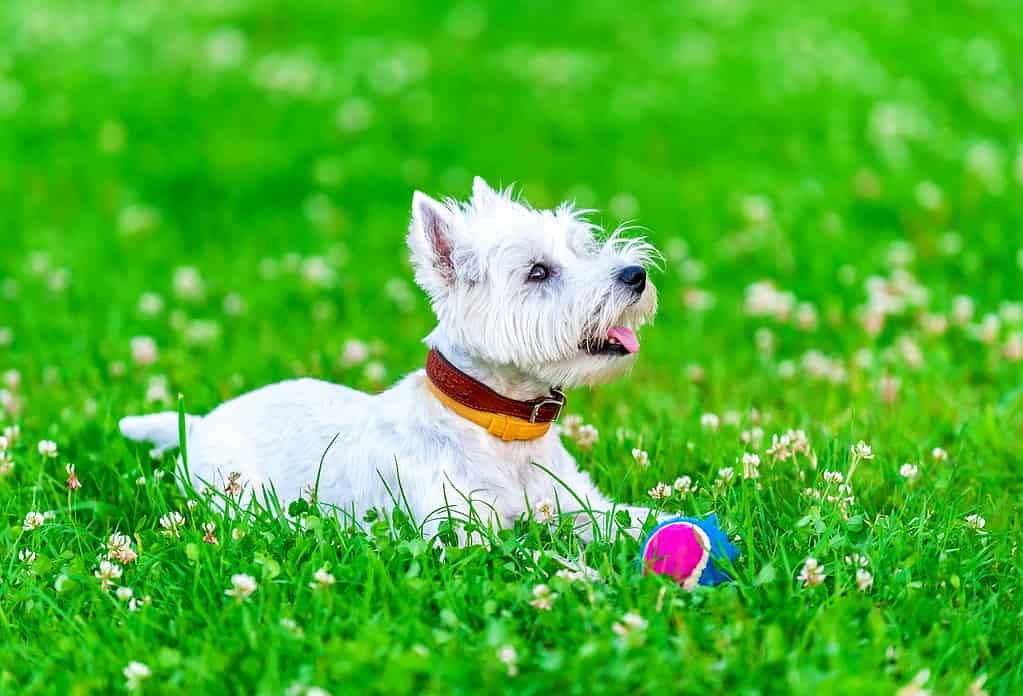
Owners should start training their Scottish terrier when they bring them home at eight or nine weeks.
©nickpo/iStock via Getty Images
Thanks to the Scottish terrier’s stubbornness and high prey drive, training is vital as early as you can start it. Once you bring your eight-week-old Scottish terrier home, you can begin with potty training, crate training, and basic commands.
Dr. Newton cautiously warns owners about the Scottie’s prey drive when taking them in public or leaving them unattended in a fenced backyard. As with any breed, Scotch terriers thrive with positive reinforcement so yelling or scolding won’t do much good.
“Remember, a Scottie’s urge to chase is as natural as its iconic beard. This means a firm recall command and always being vigilant during off-leash times is vital. They can also be a tad reserved with strangers but extremely loyal to their families. Socialization from an early age is crucial.”
Manners and Etiquette
Socialization can take different forms with your Scottie. If you already have dogs or cats at home, your Scottie will learn how to coexist with them. Remember to never leave multiple animals unsupervised for a long period, even if they’re friendly with each other. If your Scottie makes up a single-dog household, consider one-on-one meetings with loved ones’ dogs or puppy training courses at your local pet store.
“Lastly, Scotties are known diggers,” Dr. Newton continued. “It’s often joked, ‘Give a Scottie a garden, and he’ll redesign it for you!’ It’s essential to provide them with designated digging spots or toys to satisfy this instinct.”
According to Dr. Linda Simon, an expert on the veterinary consult team for TryFetched.com, an informative pet blog focused on health, supplements, and behavior, “This breed is known for being stubborn and they often choose when they would like to listen and to whom. Those breed members who are not food orientated can pose a particular challenge as they can be hard to motivate and to keep engaged.”
When training, understanding what motivates your Scottie will make lessons easier — and more fun — for both of you. Whether it’s food, toys, snuggles, treats, or unstructured playtime, make sure you reward your Scottie for their hard work when training is done.
What Commands Should I Teach My Scottish Terrier First?
When training your Scottie, consider the lifestyle you’d like to live with your dog. Will you want to bring him or her with you on errands around town, will you compete in shows, or are you simply looking for a watchful companion to spend your weekends with? This answer will inform your training progression.
The very first commands to teach your Scottie, regardless of lifestyle, include the foundational four:
- Their name.
- Sit.
- Stay.
- Come (recall).
These basic commands serve as the ground level for the rest of your training lessons. Outside of having a sense of self, your Scottie learning its name can double as a “stop” word depending on training.
Sit gives your Scottie a neutral position to always return to. Stay provides a command that builds the relationship between you and your Scottie, keeps them safe, and practices obedience in the face of external stimuli. Similarly, come is another command that trains dogs to ignore stimuli in favor of returning to their owner.
Other beginning commands you may want to teach your Scottie include:
- Drop it and/or leave it.
- Down.
- Wait.
- Lay down.
- Off.
- No.
With the Scottish terrier’s independent streak and confident nature, owners should build boundaries early. The commands above can save your Scottie from stressful or dangerous situations, like altercations with other animals, accidentally getting out of the house, or hurting themselves on something in the house.
Common Health Issues Your Scottish Terrier Might Experience

Scotties are generally healthy dogs but have a predisposition for four different diseases.
©MayWhiston/iStock via Getty Images
Though generally healthy, the Scottish terrier has the potential to inherit mutated genes from its parents and become predisposed to certain diseases. The Scottish Terrier Club of America compiled a list of the most common genetic disorders in Scotties, including:
- Scottie cramp, a disease named after the breed which makes it difficult for a dog to run or walk. It comes from a deficiency of serotonin in puppyhood.
- VonWillebrand’s disease, a bleeding disorder.
- Cerebellar abiotrophy, which degenerates a dog’s cerebellum over time.
- Craniomandibular osteopathy, a bone disease causing pain around the dog’s mouth.
Like any other pure or mixed breed dog, Scotties’ health will slightly deteriorate as they live longer. Scotties of advanced age may develop liver shunts, cataracts, hip dysplasia, and patellar luxation (a displaced kneecap).
Regular vet trips and checkups will monitor your dog’s health, especially as they age. Vets with experience in caring for Scottish terriers know the signs to look for with the most breed-specific diseases.
Pictures of Scottish Terrier as Puppies

Nine week old Scottish terrier puppies can start learning potty training.
©Stephen Barnes/iStock via Getty Images

Young Scotties need lots of exercise to stay healthy and engaged.
©SergeyTikhomirov/iStock via Getty Images
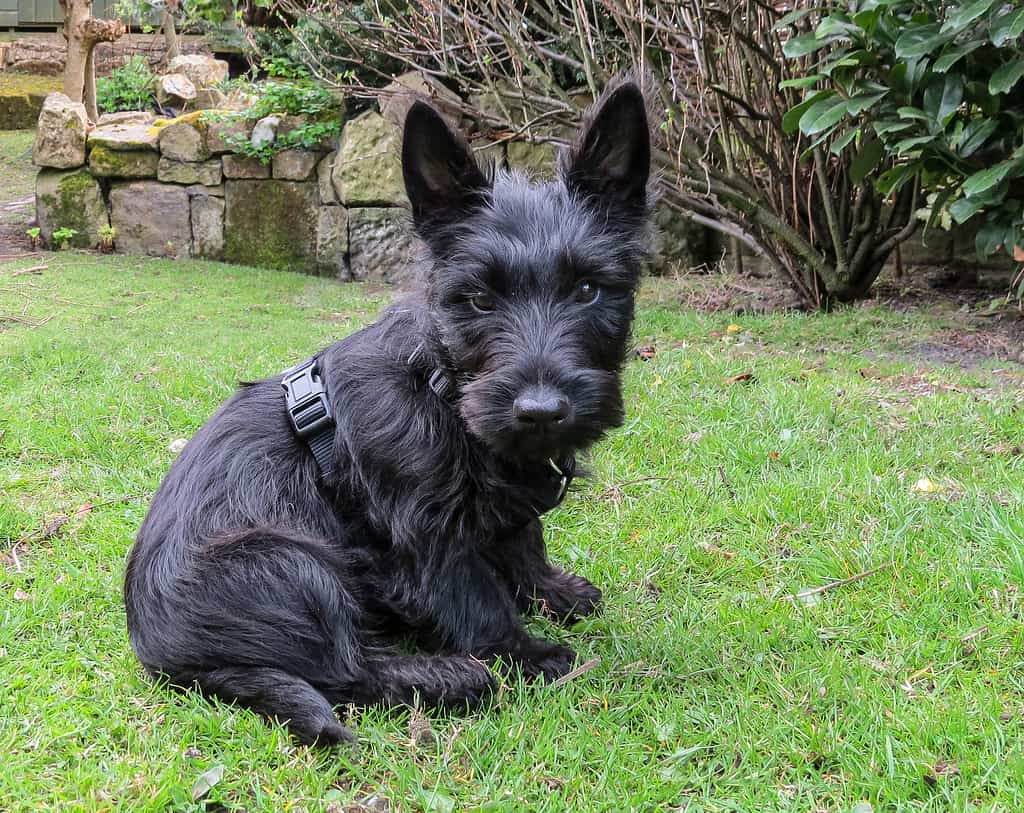
Scottish terrier puppies will grow the most between six to eight months old.
©Caymia/iStock via Getty Images
Pictures of Scottish Terrier at 6 Months
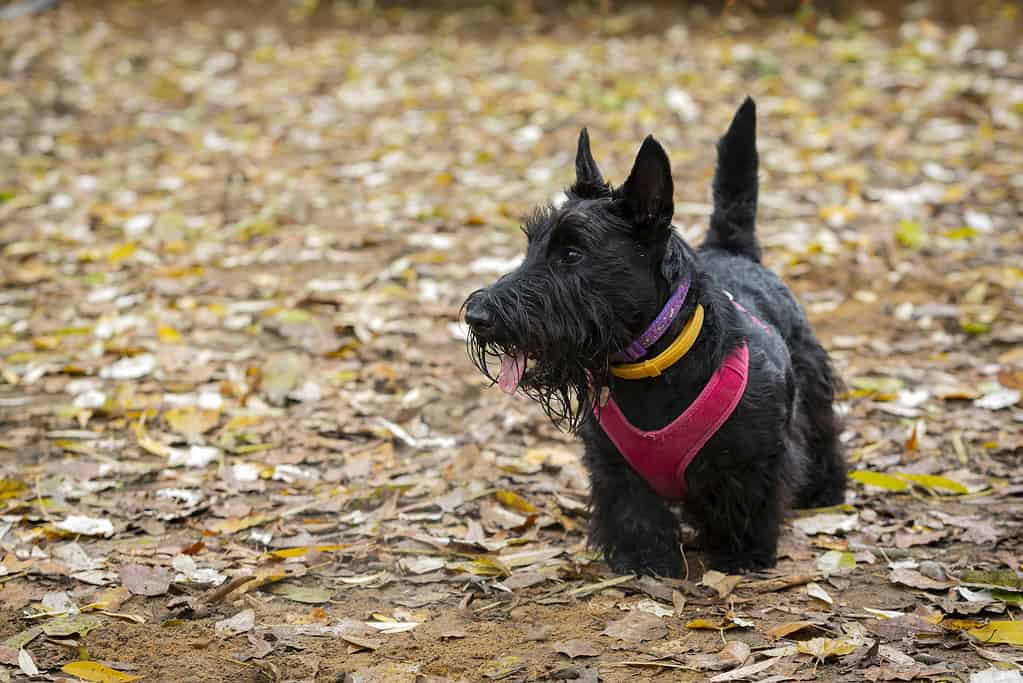
The Scottish terrier’s name in Scottish Gaelic is
Abhag Albannach.
©Andrey Kanyshev/iStock via Getty Images

As of 2022, the Scottie ranked 60 out of 200 most popular dog breeds.
©Stephen Barnes/iStock via Getty Images
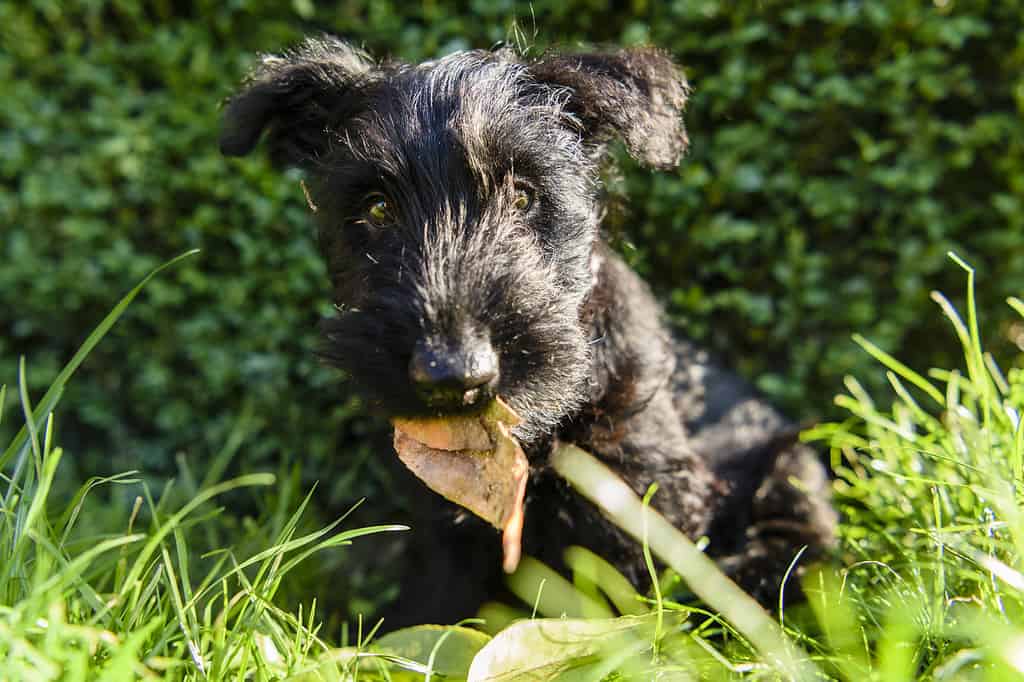
Watch your Scottie when they’re outside and still young, as they might curiously eat something that will hurt their stomach.
©Stephen Barnes/iStock via Getty Images
Pictures of Fully Grown Scottish Terrier
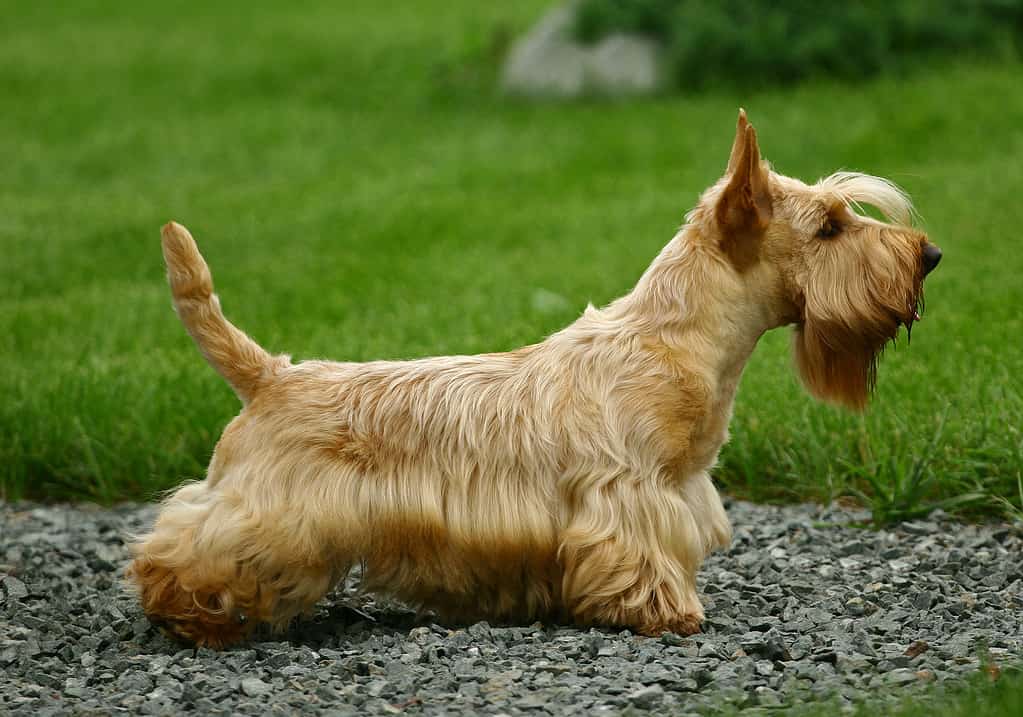
The colors of a Scottie’s coat include black, wheaten, and brindle.
©Pavel Shlykov/iStock via Getty Images

The wheaten Scottish terrier looks like it has white fur in some coat variations.
©Ondrej Prosicky/iStock via Getty Images
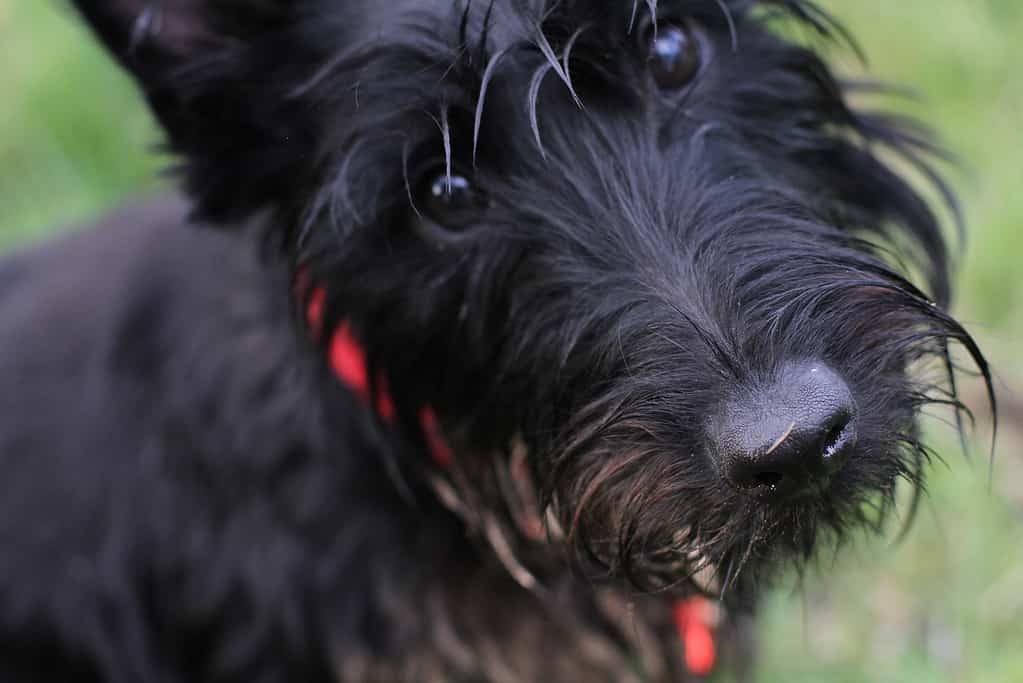
Scottish terriers have piercing eyes that remain alert for strangers and intruders.
©Kimi Hochadel/iStock via Getty Images
Other Dog Breeds Similar to Scottish Terrier
Not sure if a Scottish terrier is right for you? Consider a few other breeds that look like the Scottie and have similar lineage but different dispositions.
The photo featured at the top of this post is © Nemyrivskyi Viacheslav/iStock via Getty Images
Ready to discover the top 10 cutest dog breeds in the entire world?
How about the fastest dogs, the largest dogs and those that are -- quite frankly -- just the kindest dogs on the planet? Each day, AZ Animals sends out lists just like this to our thousands of email subscribers. And the best part? It's FREE. Join today by entering your email below.
Thank you for reading! Have some feedback for us? Contact the AZ Animals editorial team.







